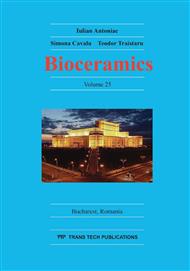[1]
Walter MH, Wolf BH, Wolf AE, Boening KW. Six-year clinical performance of all-ceramic crowns with alumina cores. Int J Prosthodont 2006; 19: 162–163.
Google Scholar
[2]
Gallucci GO, Grütter L, Nedir R, Bischof M, Belser UC. Esthetic outcomes with porcelain-fused-to-ceramic and allceramic single-implant crowns: a randomized clinical trial. Clin Oral Implants Res 2011; 22: 62–69.
DOI: 10.1111/j.1600-0501.2010.01997.x
Google Scholar
[3]
Pogoncheff C, Duff R. Use of zirconia collar to prevent interproximal porcelain fracture: a clinical report. Journal of Prosthetic Dentistry. 2010; 104: 77-79.
DOI: 10.1016/s0022-3913(10)60095-9
Google Scholar
[4]
Cortellini D, Canale A., Clinical flexibility of the metal-free approach, The European Journal of Esthetic Dentistry, 2009; 1 (8): 110-132.
Google Scholar
[5]
Schwarz S, Schroder C, Hassel A, Bomicke W, Rammelsberg P. Survival and chipping of zirconia-based and metal-ceramic implant supported single crowns. Clinical Implant Dentistry and Related Research, 2012; 14: 119-125.
DOI: 10.1111/j.1708-8208.2011.00388.x
Google Scholar
[6]
Al-Amleh B, Lyons K, Swain M. Clinical trials in zirconia: a systematic review. J Oral Rehabil. 2010; 37(8): 641-52.
DOI: 10.1111/j.1365-2842.2010.02094.x
Google Scholar
[7]
Bieniek KW, Marx R. The mechanical loading capacity of new all-ceramic crown and bridge materials. Schweiz Monatsschr Zahnmed 1994; 104: 284–289.
Google Scholar
[8]
Sax C, Hämmerle CH, Sailer I. 10-year clinical outcomes of fixed dental prostheses with zirconia frameworks. Int J Comput Dent. 2011; 14(3): 183-202.
Google Scholar
[9]
Heintze SD, Rousson V. Survival of zirconia- and metal-supported fixed dental prostheses: a systematic review. Int J Prosthodont. 2010 Nov-Dec; 23(6): 493-502.
Google Scholar
[10]
Sailer I, Gottner J, Kanel S, Hammerle CH. Randomized controlled clinical trial of zirconia-ceramic and metal-ceramic posterior fixed dental prostheses: a 3-year follow-up. Quintessence Int J. 2009; 22(6): 553-560.
Google Scholar
[11]
Schwarz S, Schroder C, Bomicke W, Hassel A, Rammelsberg P. A retrospective study on the incidence of chipping of zirconia-based and metal-ceramic implant-supported single crowns and splinted crowns. Zahnarztl Impl I. 2012; 28(2): 138-46.
DOI: 10.1111/j.1708-8208.2011.00388.x
Google Scholar
[12]
Al-Dohan HM, Yaman P, Dennison JB, Razzoog ME, Lang BR. Shear strength of core-veneer interface bi-layered ceramics. J Prosthet Dent 2004; 91: 349-355.
DOI: 10.1016/j.prosdent.2004.02.009
Google Scholar
[13]
Nothdurft F, Pospiech P. Prefabricated zirconium dioxide implant abutments for single-tooth replacement in the posterior region: evaluation of peri-implant tissues and superstructures after 12 months of function. Clin. Oral Impl. Res. 21, 2010; 857–865.
DOI: 10.1111/j.1600-0501.2009.01899.x
Google Scholar
[14]
Seung-Ryong Ha, Sung-Hun Kim, Jung-Suk Han, Seung-Hyun Yoo, Se-Chul Jeong, Jai-Bong Lee, In-Sung Yeo The influence of various core designs on stress distribution in the veneered zirconia crown: a finite element analysis study. J Adv Prosthodont. 2013 May; 5(2): 187–197.
DOI: 10.4047/jap.2013.5.2.187
Google Scholar
[15]
McLaren E, Hyo L, CAD/CAM Update: Technologies and Materials and Clinical Perspectives, Inside Dentistry. 2006; Nov/Dec: 102.
Google Scholar
[16]
Sailer I, Philipp A, Zembic A, Pjetursson B, Hammerle C, Zwahlen M. A systematic review of the performance of ceramic and metal implants abutments supporting fixed implant reconstructions. Clin Oral Impl Res. 2009; 20: 4-31.
DOI: 10.1111/j.1600-0501.2009.01787.x
Google Scholar


